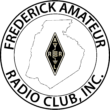Come one, come all to the October meeting of the Frederick Amateur Radio Club, to be held on Monday, October 21st at 7pm. We meet in the Social Hall of the Independent Hose Company, which is located at 310 Baughmans Lane in Frederick. Parking and entrance are in the rear of the building. This month, we’ll have an extended discussion regarding the 146.64 K3ERM repeater, which is currently experiencing difficulties. In addition, the floor will be open to discussion of any ham radio relevant topic. Bring your questions, your radios, or whatever you might need help with.
Club meetings are open to anyone from the greater community who has even the slightest interest in amateur radio.
While joining in person is always best, sometimes, that’s just not possible. If you can’t be there in person, join us via Zoom using this link:
https://us02web.zoom.us/j/86031809702?pwd=bkFCM0pYL0g1RndpZVNjd01rN2FYQT09
If you join via Zoom, PLEASE either include your call sign or name in your Zoom profile. This will help identify you as a human and not a bot. Thanks!
Upcoming events:
Saturday October 26th: Club Simulated Emergency Test (aka SET).
2024 FARC SET Exercise
Version 1.0
When: 0900 – 1200L, 26 Oct 2024
Where: Frederick County MD
Why: A simulated ice storm has knocked out power to the county. Cell service is down. Temperatures are plummeting, warming shelters have been activated at local parks and public schools.
How: The Frederck County Health Department (FCHD) has tasked the FARC to deploy two communication pods (HAM1 and HAM2) to 2 separate county warming shelter stations located at public schools. These stations will:
1. Setup UHF/VHF/6m HF/GMRS ch15 communication channels and establish connectivity between HAM1 and HAM2 at 0900. Initial setup will be Channel 1 W3FDK on A and Channel 2 K3ERM on B using the FT-8900 radio.
2. Verify which of channels 1 – 10 connect HAM1 to HAM2. Establish whether HAM1 or HAM2 will initially record APRS while the other records voice traffic. These rolls will switch back and forth periodically to enable winlink message retrieval and APRS tracking/message retrieval.
3. Begin a roll-call for participants to check-in on channel 1 (W3FDK-R).
4. Participants are asked to report their current environment (home or shelter) temperature reading by either voice, APRS message, APRS position comment, Winlink, or use all modes. For those using Winlink please utilize RRI Quick Welfare Message txt and send it to KB3EOF with cc to K3MMM, and include a phone msg to me at 301-524-5823 (verizon) or a concerned spouse/relative (emphasize “exercise” in the message). Don’t forget to include your environmental temperature and GPS or What 3 Words location for your home or park or school parking lot (exercise shelter).
5. Exercise completed at 12 noon.
Read More
